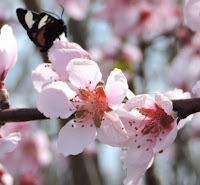 |
| Striding across the pond - REK |
Water striders were dancing on the pond surface in large numbers last Saturday, prematurely celebrating the early arrival of spring. Their ability to seemingly defy gravity is entertaining to all who watch as seen in
my video from that day. The secret to its delicate ballet is really that of one of the amazing properties of water called surface tension.
Striders are bugs (Hemiptera) in the
Gerridae family. Most have wings although that may vary between generations (wing polymorphism), some having long wings to migrate distances to establish new territory, others short wings for short trips. At other times they may have none at all. The advantage of having wings may be outweighed (literally) by the added weight they have to carry across the water surface. Like other Hemiptera, they have sucking mouth parts which can pierce their prey, digesting them externally and sucking in the contents.
Each of its three pair of legs serve a different function. The front pair are equipped with claws in the middle like a preying mantis, allowing them to grab and puncture their prey. The middle pair serves as oars, quickly propelling them across the water while the longer back legs support their weight and act as rudders. When they sense vibrations or waves from a struggling insect, they can turn rapidly and attack as fast as one meter a second.
 |
| Responding to a twig thrown in the water - REK |
The
surface tension of water is a key to their success. You can experience this yourself by floating a coin on water as demonstrated with
this video. The scientific explanation is as follows:
"At liquid-air interfaces, surface tension results from the greater attraction of liquid molecules to each other (due to cohesion) than to the molecules in the air (due to adhesion).
The net effect is an inward force at its surface that causes the liquid
to behave as if its surface were covered with a stretched elastic
membrane. Thus, the surface becomes under tension from the imbalanced
forces, which is probably where the term "surface tension" came from." Wikipedia
The other factor is the cluster of tiny hydrophobic hairs covering their body, over 1,000 microhairs per millimeter. On the legs, they keep the strider on top of the water, riding on the surface tension. The hairs on the body prevent wetting even from rain, that otherwise would weigh them down.
 |
| The elastic surface tension is stretched under each leg - Stan Lupo |
Mating rituals require communication between the sexes, and male water striders send their courtship
message through water vibrations. They send out three different frequencies of water ripples. A high frequency 25 Hz repel signal or a lower 10 Hz threat signal are warnings. If a repel signal isn't returned by another water strider, the male knows it is a female. Then he gives the lowest frequency 3 Hz signal signifying courtship, the Barry White approach to romance.
It gets even more complicated as described in
this Discover magazine article. Studies suggest that when females resist mating, the mounted males can send out vibrations that would attract predators such as backswimmers and fish. Since these attack from below, the vulnerable female is more likely stop resisting the mating.
High speed video of water striders and surface tension.






 My favorite locust eater is the Honey Locust Bean Weevil. You can read all about it here including watching it dance on a video. Knowing that its kin are eating up the bean seeds makes me feel better about the thorn stabs..... a little.
My favorite locust eater is the Honey Locust Bean Weevil. You can read all about it here including watching it dance on a video. Knowing that its kin are eating up the bean seeds makes me feel better about the thorn stabs..... a little.










































